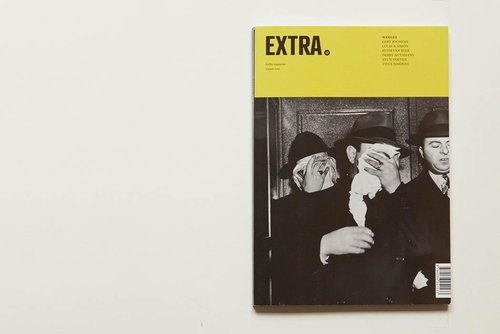
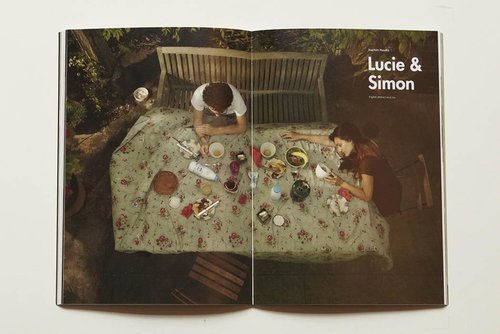


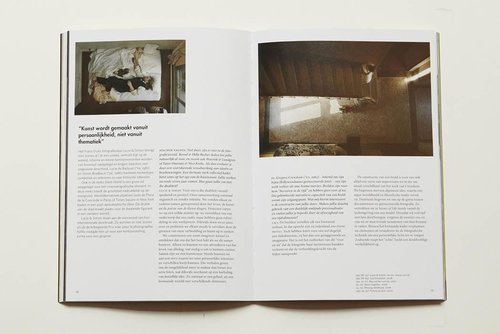
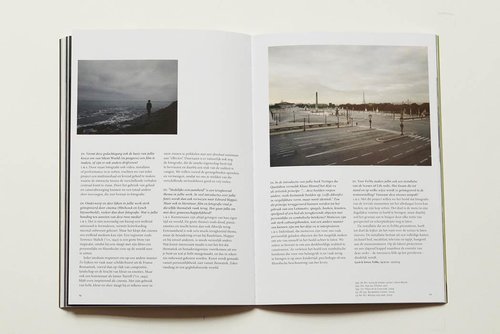
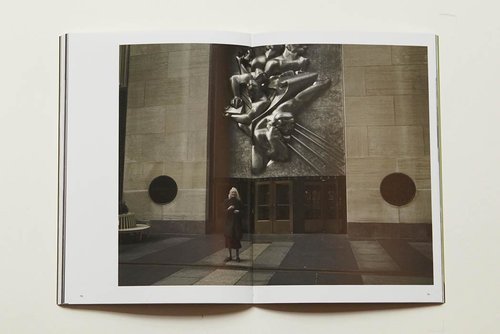
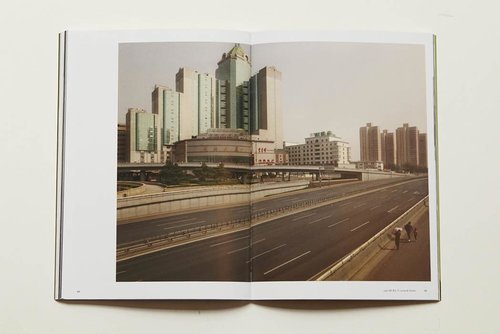
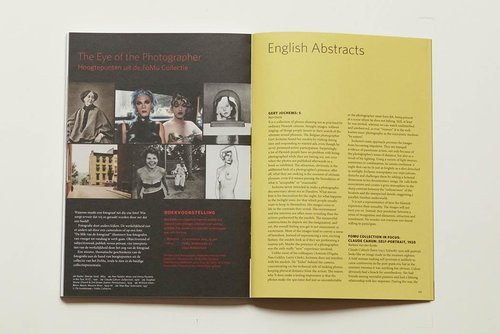
EXTRA
EXHIBITION CATALOGUE, NOVEMBER 2012
Fotomuseum Antwerpen, Belgium
Interview by Joachim Naudts.
QUESTION: There aren’t that many duos in contemporary photography/art (Bernd & Billa Becher of course, but also Gilbert & George, Wassink & Lundgren and Taiyo Onorato & Nico Krebs). A photographic ‘partnership’ doesn’t sound that easy. The recently deceased Martine Franck once cancelled one of her shows because her husband Henri Cartier-Bresson was meant to be present on the opening reception (according to the invitation). You have been working together for nearly 7 years now. How do you handle this duality? How do you ‘divide’ the process on the artistic level? Or, if you don’t ‘divide’, how do you cope with differences, autonomy, diverging interests, … in relation to you photographic work?
L&S: The duality is something really natural and positive to us. We never really taught about working with each other in the first place, everything just happened slowly and without intention. We found each other, got inspired and started sharing a lot about life, art, and the poetry of little things.
We don’t divide our work process or have specialities, we just spend a few years on a project, on a subject that really moves us from a philosophical and technical point of view regarding Art, and from their on we share ideas, thoughts, inspirations and try to enrich each other as much as possible and study the frontiers between our imagination and art. It is like building an imaginary castle and we realized we were two building it. We need to be together to form this one artist, and need to isolate ourselves in our common world to create something.
In each project we try to build what we call “a story”, an imaginary world in itself, which makes it also possible for both of us to involve our personal interests and differences.
“Stories” allow us to be larger than “series” which are often a repetition of the same image.
This is why we always realize different points of view in each projects, we really love a “story” to be an entity, a whole independent world in itself and this certainly allows us to include a lot of different parts of us.
Q: This idea of “stories” reminds me of the notion “one-frame movies” and the work of Gregory Crewdson. This american photographer – known for his elaborate staging which resembles and deals with hollywood film-sets – deliberately struggles with the limited narrative capacity of images. He argues that images are frozen in time, where there’s no before or after. my interest lies in the construction of this story: firstly: do you have your own fixed narrative in mind and construct a scene based on this ? And secondly: do you feel limited by the absence of a time-dimension?
L&S: We always think an image as a single story that shouldn’t be linked to another image. So your notion of one frame story is really accurate.
But then, we wouldn’t completely agree with the idea that there is no “before and after” a photographic image. It is of course not clearly known as in a movie or a video, but it is suggested, imaginary, which makes photography particularly mysterious as a medium. This mystery provoked by the absence of a time dimension allows each viewer to interpret our work with his own different feelings and imagination. This is something really important to us.
The way we construct our images and stories is always slow and very much linked with improvisation.
It is therefore very different from Gregory Crewdson’s work where all elements are constructed “for” the image like on a movie set. First comes the general idea of a project, which is linked to a look we want to have on the world, and a philosophical study. We always try to work on the frontier between documentary photography (places and elements on which we don’t interfere) and staged photography (elements or people on which we interfere). Most parts of the images are always as they are in “real life”. For example, all people photographed for the “scenes of life” are simply shot in their own places in trivial moments of existence. We always try to let them as free as possible and spend so much time with them that they start forgetting us.
Then in this solid frame we move some elements here and there, or shift the photography technique, and try to add a personal fiction, something that transports the real image into an “imaginary reality”.
Q: Is this also why you made a movie from the “Silent world” series (which is still in progress) or are there other objectives for this?
L&S: With the construction of a video we can create a whole different atmosphere to the project, thru the work of sound and camera movement, which doesn’t exist in photography, it allows us to give an additional feeling to the project and the exhibitions.
Also, we often try to mix medias in our exhibitions so that there is an interaction between the “stories”, and the way each medium interacts with the viewers, whether it is photography, video, installation or performance. We try to make each project really living.
Q: With regards to ‘topics’ and ‘atmosphere’, your work is mainly influenced by cinema (Hitchcock and Lynch, amongst others). Do you feel more comfortable with cinema as opposed to photography? Can you try to elaborate on your position towards (or between?) these mediums?
L&S: That’s a difficult question to answer as most of this happens subconsciously. Every medium inspires us differently, but it is true that cinema, when directors make you lose yourself in their own vision of the world, can be a very touching medium.
A director such as Terrence Malick is a great inspiration to us because he achieves to share thru images a personal and philosophical vision and study of the world. This is rare and unique, far from entertaining movie business, but this is where cinema is linked to art and inspires us.
But then, each medium touches us differently. We are very inspired by French paintings from the Romanticism period, in terms of composition, scenery and the power of colours and emotions. This also an important element to us when it comes to compose or think images and projects.
We also admire the work of artist James Turrell, which is based on light, colour and ‘atmosphere’. This is as inspiring as movies, if not more, because it achieves to touch all your senses with a minimum of “effects”.
And finally, photography has this unique asset that it is frozen in time and catches reality, as mentioned earlier. And what interests us is to challenge these frontiers and try mixing those elements.
So to answer your question, I think we feel comfortable and free in the middle of all these mediums.
Q: Most of your work seems to deal with ‘urban solitude’ (also, or even more so, your latest series – still in progress – ‘silent world’). A theme that’s quite common in painting (hopper, as mentioned in quite a few of introductory texts to your work), but also in literature, film, photography, … how do you deal with this ‘commonness’? Simply because of this theme being often used, there arise quite a few pitfalls. how do you try to avoid those?
L&S: Art and artists have always been witnesses of their world and time in a way. There has always been a few great “themes” such as life and death, passion, feelings or power to name a few. Solitude is one of those as well of course in any form of art, from Baudelaire to Edward Hopper, as you mentioned it, and other great inspirations.
All being very different of course, because it depends how and by whom it is realized and interpreted.
As an artist you don’t really chose consciously everything you do and how you do it. That’s what makes art interesting! Your feelings, what you are and what you’ve been thru always emanate and model your work, and hopefully make it personal and different. We truly believe it is the inside of the artist that makes his work personal, not the theme he is working on, especially today in a globalized world.
With time we realized solitude was one of our main themes. But you have numerous others of course: imagination, fiction and reality, life, childhood…This makes it a different interpretation of our world, not necessarily a good one, but a personal one.
A theme such as “solitude”, as you mentioned it, will always be interesting for artists because from a decade to another, from a country or system to another, the interpretation done will always say something about the world we live in and its evolution.
Q: Anne bogart states “a stereotype is a container of memory”. Stereotypes are often regarded as unoriginal in art, but bogart argues that “lighting a fire under a stereotype” can provided a nuanced understanding of some discovered truth. interpretation is one thing to “light a fire”, but the photographer is the one ‘constructing’ an image. Isn’t he the only one responsible for that fire?
L&S: The way we see our work is very simply a way of expressing ourselves in the most personal way as possible. Creating these stories, imaginary or real, working with people and trying to understand and explore something about them and us at the same time is what keeps us going.
The results are our “stories”, for which we are responsible, but which we refuse to explain in details in order to let the viewers have their own personal opinion. Once we are done with a work it gets opened and accessible to anyone, and any viewer will have his own interpretation of it: positive, negative or uncaring.
Q: In the introduction to your book vertiges du quotidien, Klaus Honnef mentions “deja-vu” as an artistic principle: “… these images bring to mind others that have already existed (even rather often) in comparable form, although never identical.” This principle might be retraced to the use of ‘leitmotifs’ (mirrors, books/newspapers, children toys, bed, …), recurring objects with a (personal) symbolic meaning. Do you agree or are these motives purely accidental? Leitmotifs are also prone to cultural biasing, which might be another way of interpreting the “deja-vu”.
L&S: As you mentioned it, these recurring objects: “leitmotifs”, are often personal elements which allow us to draw and insert a part of us in the image and twist it into this “imaginary reality” as we mentioned earlier. They convey a symbolic meaning to the image, which is important to us, and are often linked to childhood, psychology or a philosophical interpretation of life and situations.
Q: In FoMu you’ll also make an installation from the ‘scenes of life’ series. How will this look like and how will it be integrated in the exhibition? What guided your thoughts towards this installation and why did you choose for a different approach?
L&S: In the “Scenes of life project”, we wanted to turn upside down the vision that photography can offer about everyday life trivial moments. The goal was to put into light human beings of our time in their daily routine but shift this commonness by erasing all notions of perspective and depth of field which are inherent to photography, transform the volume of an image into a plane surface.
In the “Scenes of life installation” that will be visible at the FoMu exhibition our goal is to give the impression to the viewers to be floating over the scenes, as if they were flying over a room. The installation will consist of an entire room including bed, furniture, television, fitted-carpet… hanging on the wall of the museum. On the bed sheets a video performance of a sleeping couple will be playing continuously and bring to reality the intrusive look on private life that the entire “Scenes of life” project deals with.
The idea of this installation came from several readings and testimonies we read about people who experienced deadly accidents but which by great miracle came back to life, regained control of their body after several months of coma. A common vision sometimes shared was the souvenir of their spirit leaving the body, floating slowly and consciously above the accident scene in direction of the sky.
These readings had a great impact on us and pushed us to work on a vision that allies this experience and the common interpretation of god’s view on human-beings : from above us, from the sky.
Joachim Naudts